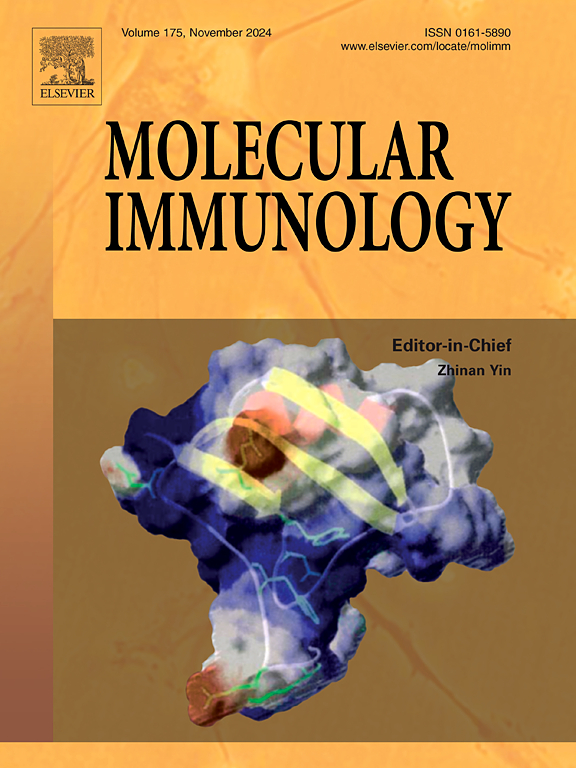NME4:一种用于透明细胞肾细胞癌预后预测和免疫治疗反应评估的新型代谢相关生物标志物
IF 3
3区 医学
Q2 BIOCHEMISTRY & MOLECULAR BIOLOGY
引用次数: 0
摘要
肾细胞癌(RCC)的发病率仍然很高,并且每年都在持续上升,组织学上透明细胞亚型占大多数病例。虽然免疫治疗部分提高了5年相对生存率,但由于个体异质性,反应率各不相同,总体预后仍然很差,特别是对于高分期患者。迫切需要识别新的生物标志物来预测患者预后和免疫治疗效果,以实现个性化治疗。方法采用单因素和多因素Cox回归分析验证NME4在透明细胞肾细胞癌(ccRCC)中的预后价值,并通过功能富集分析阐明其生物学功能。通过细胞实验验证NME4在ccRCC增殖和迁移中的作用。此外,利用TIDE (Tumor Immune Dysfunction and Exclusion,肿瘤免疫功能障碍和排斥)算法和外部数据集研究NME4对免疫治疗反应的预测能力,并使用“IOBR”软件包分析NME4与ccRCC免疫微环境的关系。最后,体细胞突变和拷贝数变异分析为NME4在ccRCC中的分子机制提供了多组学视角。结果我们的研究确定了NME4对ccRCC患者预后的预测能力,NME4高表达患者的OS和PFI更差。功能富集分析揭示了NME4的生物学功能,表明其参与多种代谢途径的重编程。细胞实验表明,NME4促进了ccRCC的增殖和迁移。TIDE算法和外部数据集表明,低NME4表达预示着对免疫治疗的更好反应。此外,在基于体细胞突变和拷贝数变异的多组学数据分析中,NME4表达亚组之间存在显著差异。结论在本研究中,我们验证了NME4对ccRCC患者预后的预测能力。同时,NME4有望成为指导免疫治疗精准应用的分子标记物。本文章由计算机程序翻译,如有差异,请以英文原文为准。
NME4: A novel metabolic-associated biomarker for prognosis prediction and immunotherapy response evaluation in clear cell renal cell carcinoma
Background
The incidence of renal cell carcinoma (RCC) remains high and continues to rise annually, with the clear cell subtype accounting for the majority of cases histologically. While immunotherapy has partially improved the 5-year relative survival rate, response rates vary due to individual heterogeneity, and the overall prognosis remains poor, particularly for high-stage patients. There is an urgent need to identify novel biomarkers for predicting patient prognosis and immunotherapy efficacy to enable personalized treatment.
Methods
Univariate and multivariate Cox regression analysis were employed to validate the prognostic value of NME4 in clear cell renal cell carcinoma (ccRCC) across four cohorts, followed by functional enrichment analysis to elucidate its biological functions. Cellular experiments were conducted to verify NME4's role in ccRCC proliferation and migration. Furthermore, the TIDE (Tumor Immune Dysfunction and Exclusion) algorithm and external datasets were utilized to investigate NME4's predictive capacity for immunotherapy response, while using the 'IOBR' package to analyze the relationship between NME4 and ccRCC immune microenvironment. Finally, somatic mutation and copy number variation analysis provided multi-omics insights into NME4's molecular mechanisms in ccRCC.
Results
Our study determined the predictive ability of NME4 for ccRCC patient prognosis, and patients with high NME4 expression had worse OS and PFI. Functional enrichment analysis revealed the biological functions of NME4, indicating its involvement in the reprogramming of multiple metabolic pathways. Cellular experiments showed that NME4 promoted the proliferation and migration of ccRCC. The TIDE algorithm and external datasets indicated that low NME4 expression predicts better responses to immunotherapy. Additionally, significant differences were observed between NME4 expression subgroups in multi-omics data analysis based on somatic mutation and copy number variation.
Conclusion
In this study, we validated NME4's prognostic predictive capacity for ccRCC patients. Meanwhile, NME4 is expected to be a molecular marker to guide the precise application of immunotherapy in clinical practice.
求助全文
通过发布文献求助,成功后即可免费获取论文全文。
去求助
来源期刊

Molecular immunology
医学-免疫学
CiteScore
6.90
自引率
2.80%
发文量
324
审稿时长
50 days
期刊介绍:
Molecular Immunology publishes original articles, reviews and commentaries on all areas of immunology, with a particular focus on description of cellular, biochemical or genetic mechanisms underlying immunological phenomena. Studies on all model organisms, from invertebrates to humans, are suitable. Examples include, but are not restricted to:
Infection, autoimmunity, transplantation, immunodeficiencies, inflammation and tumor immunology
Mechanisms of induction, regulation and termination of innate and adaptive immunity
Intercellular communication, cooperation and regulation
Intracellular mechanisms of immunity (endocytosis, protein trafficking, pathogen recognition, antigen presentation, etc)
Mechanisms of action of the cells and molecules of the immune system
Structural analysis
Development of the immune system
Comparative immunology and evolution of the immune system
"Omics" studies and bioinformatics
Vaccines, biotechnology and therapeutic manipulation of the immune system (therapeutic antibodies, cytokines, cellular therapies, etc)
Technical developments.
 求助内容:
求助内容: 应助结果提醒方式:
应助结果提醒方式:


